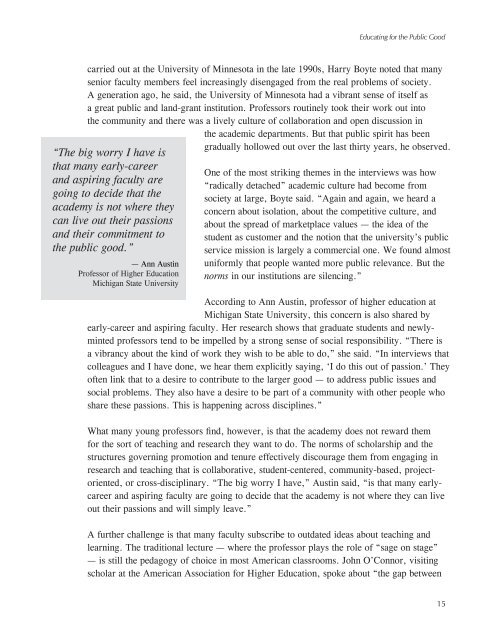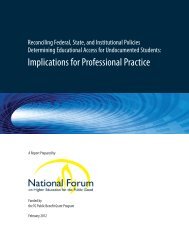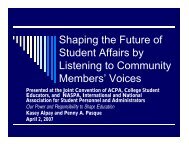The National Forum on Higher Education for the Public Good
The National Forum on Higher Education for the Public Good
The National Forum on Higher Education for the Public Good
Create successful ePaper yourself
Turn your PDF publications into a flip-book with our unique Google optimized e-Paper software.
Educating <strong>for</strong> <strong>the</strong> <strong>Public</strong> <strong>Good</strong>carried out at <strong>the</strong> University of Minnesota in <strong>the</strong> late 1990s, Harry Boyte noted that manysenior faculty members feel increasingly disengaged from <strong>the</strong> real problems of society.A generati<strong>on</strong> ago, he said, <strong>the</strong> University of Minnesota had a vibrant sense of itself asa great public and land-grant instituti<strong>on</strong>. Professors routinely took <strong>the</strong>ir work out into<strong>the</strong> community and <strong>the</strong>re was a lively culture of collaborati<strong>on</strong> and open discussi<strong>on</strong> in<strong>the</strong> academic departments. But that public spirit has beengradually hollowed out over <strong>the</strong> last thirty years, he observed.“<str<strong>on</strong>g>The</str<strong>on</strong>g> big worry I have isthat many early-careerand aspiring faculty aregoing to decide that <strong>the</strong>academy is not where <strong>the</strong>ycan live out <strong>the</strong>ir passi<strong>on</strong>sand <strong>the</strong>ir commitment to<strong>the</strong> public good.”— Ann AustinProfessor of <strong>Higher</strong> Educati<strong>on</strong>Michigan State UniversityOne of <strong>the</strong> most striking <strong>the</strong>mes in <strong>the</strong> interviews was how“radically detached” academic culture had become fromsociety at large, Boyte said. “Again and again, we heard ac<strong>on</strong>cern about isolati<strong>on</strong>, about <strong>the</strong> competitive culture, andabout <strong>the</strong> spread of marketplace values — <strong>the</strong> idea of <strong>the</strong>student as customer and <strong>the</strong> noti<strong>on</strong> that <strong>the</strong> university’s publicservice missi<strong>on</strong> is largely a commercial <strong>on</strong>e. We found almostuni<strong>for</strong>mly that people wanted more public relevance. But <strong>the</strong>norms in our instituti<strong>on</strong>s are silencing.”According to Ann Austin, professor of higher educati<strong>on</strong> atMichigan State University, this c<strong>on</strong>cern is also shared byearly-career and aspiring faculty. Her research shows that graduate students and newlymintedprofessors tend to be impelled by a str<strong>on</strong>g sense of social resp<strong>on</strong>sibility. “<str<strong>on</strong>g>The</str<strong>on</strong>g>re isa vibrancy about <strong>the</strong> kind of work <strong>the</strong>y wish to be able to do,” she said. “In interviews thatcolleagues and I have d<strong>on</strong>e, we hear <strong>the</strong>m explicitly saying, ‘I do this out of passi<strong>on</strong>.’ <str<strong>on</strong>g>The</str<strong>on</strong>g>yoften link that to a desire to c<strong>on</strong>tribute to <strong>the</strong> larger good — to address public issues andsocial problems. <str<strong>on</strong>g>The</str<strong>on</strong>g>y also have a desire to be part of a community with o<strong>the</strong>r people whoshare <strong>the</strong>se passi<strong>on</strong>s. This is happening across disciplines.”What many young professors find, however, is that <strong>the</strong> academy does not reward <strong>the</strong>m<strong>for</strong> <strong>the</strong> sort of teaching and research <strong>the</strong>y want to do. <str<strong>on</strong>g>The</str<strong>on</strong>g> norms of scholarship and <strong>the</strong>structures governing promoti<strong>on</strong> and tenure effectively discourage <strong>the</strong>m from engaging inresearch and teaching that is collaborative, student-centered, community-based, projectoriented,or cross-disciplinary. “<str<strong>on</strong>g>The</str<strong>on</strong>g> big worry I have,” Austin said, “is that many earlycareerand aspiring faculty are going to decide that <strong>the</strong> academy is not where <strong>the</strong>y can liveout <strong>the</strong>ir passi<strong>on</strong>s and will simply leave.”A fur<strong>the</strong>r challenge is that many faculty subscribe to outdated ideas about teaching andlearning. <str<strong>on</strong>g>The</str<strong>on</strong>g> traditi<strong>on</strong>al lecture — where <strong>the</strong> professor plays <strong>the</strong> role of “sage <strong>on</strong> stage”— is still <strong>the</strong> pedagogy of choice in most American classrooms. John O’C<strong>on</strong>nor, visitingscholar at <strong>the</strong> American Associati<strong>on</strong> <strong>for</strong> <strong>Higher</strong> Educati<strong>on</strong>, spoke about “<strong>the</strong> gap between15




